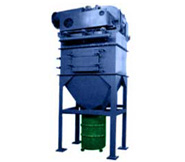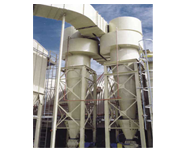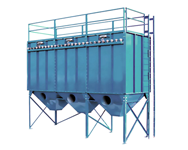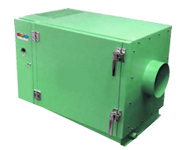| |
 |
BAFFLE TYPE
Baffle chambers use a fixed baffle plate that causes the conveying air steam with dust particles to make a sudden change of direction.
Large particles fall down or stick to the baffle, which can be easily cleaned periodically. Baffle type dust collector are suitable for coarse particles. Advantages are very low maintenance, simple in construction and no consumables.
|
|
| |
| |
CYCLONE SEPARATOR
Cyclones are commonly used in removal of course dust from air or gas stream. Cyclone separator is based on the action of inertial (centrifugal) forces upon dust particles. Dusty air is introduced at the top of a cyclone tangentially. The gases, then move downwards in a whirling motion, forming a peripheral vortex and giving rise to centrifugal forces, resulting partials downwards into the hopper.
The principle advantage is low cost, low maintenance, low pressure drop. Suitable for high dust concentrations. Cyclone separator is used in Pneumatic conveying, cement industries, Coal handling, Pulverising etc. |

|
|
| |
 |
BAG FILTER
Bag filter are one of the most efficient types of dust collectors available and can achieve a collection efficiency of more than 99% for very fine particulates. The dust laden air is passed through the walls of the bags. The dust is separated and deposited as a layer on wall of the bags. It is then removed from the bags by manual or mechanical shaking, or by pulse jet cleaning mechanism.
Considering the type of dust its characteristics and temperature, fabric is selected. We can offer fabric filters of polyester, polypropylene, polyester needle felt, polypropylene nylon etc. depending upon requirements.
|
|
| |
| |
ELECTROSTATIC PRECIPITATOR (ESP)
Electrostatic precipitators (ESP) use electrostatic forces to separate dust particles from exhaust gases. A number of high-voltage, direct-current discharge electrodes are placed between grounded collecting electrodes. The contaminated gases flow through the passage. The airborne particles receive a negatively charged and attracted to a grounded or positively charged electrode and adhere to it.
The collected material on the electrodes is removed by rapping or vibrating the collecting electrodes. ESPs are suitable for low gas flow rates, particle takes time to react. ESPs are often used for mist or fog collection or for adhesive, sticky, radioactive, or extremely toxic materials.
|

|
|
| |
|
| |

Back to Top |
|
|
